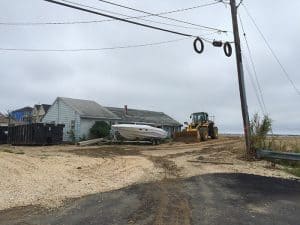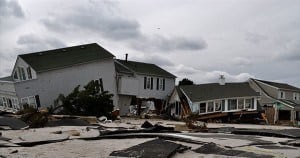
The Seaside boardwalk is back. The bridges, too. But you don’t have to look too hard to find remnants of Superstorm Sandy’s devastation along the Jersey Shore.
 A line of waterfront homes is marred by a deserted house. A vacant property with the footprint still visible. A house being rebuilt on the water. These are the physical scars that Sandy had been there. The emotional scars are usually harder to see.
A line of waterfront homes is marred by a deserted house. A vacant property with the footprint still visible. A house being rebuilt on the water. These are the physical scars that Sandy had been there. The emotional scars are usually harder to see.
Many people are still struggling with the psychological effects of Sandy. The time it takes to get back in one’s home is longer than the length of some of the programs to help people.
Tricia McAvoy has not been able to move back in to her house in Brick yet. Instead, she’s staying with her 100-year-old father in Point Pleasant Beach.
“I cannot physically go into that house alone without shaking,” she said.
It hasn’t been fully restored. There have been a host of construction issues, contractor issues, RREM issues, and more. From the outside, it looks like it’s complete, although looking beneath the surface you would be able to see the problems that continue to keep her from coming home. There’s always something else to go wrong.
“You’re waiting for the next shoe to drop. You don’t want to open any letters. I’m afraid, sometimes, to answer the phone,” she said.

There are physical after-effects as well. She said she developed chronic bronchitis and has had two strokes since the storm. She used to be healthy, but now she’s on 11 pills a day.
“A lot of the stress is having to deal with the insurance company,” she said. “The stress will kill you.”
After Sandy, she worked in one of the relief centers. She was also photographed holding a sign that read “Hope.”
“Whenever there’s heavy rains, I get so nervous I start shaking,” she said. “It’ll never leave you.”
She’s not alone. The New Jersey Organizing Project was formed by a group of people who survived Sandy. They recently accumulated surveys from 492 households about what problems they are still facing. A large amount of them were in Ocean and Monmouth counties. More than 70 percent of them reported additional medical or psychological issues, or a worsening of pre-existing conditions since the storm.
“Many individuals described anxiety, depression, and post-traumatic stress disorders, often in combination with respiratory, cardiovascular, or other conditions,” according to their report, The Long Road Home. It can be found online at NewJerseyOP.com. “Many people also described an increased dependence on alcohol, tobacco products, or drugs. Of families with children, nearly 40 percent reported that their children’s school performance suffered because of the difficulties their family has faced since the storm.”
The full report outlines a score of issues that were left unresolved: people still dealing with contractors or the government, and 57 percent of them saying they think that this could happen again because towns are not prepared.
The report suggests solutions such as:
- The process for clawbacks should be changed to allow people to appeal, have payment plans, or have it forgiven based on their ability to pay.
- Contractors should be more thoroughly screened.
- The National Flood Insurance Program, and the flood maps, should be changed.
- A unified approach to climate change and sea level rise should be led by Trenton.
- Provide longer-term mental and physical health assistance and programming, since the effects of the storm last for years.
Finding Help Now

There was a great outpouring of mental health help immediately after Sandy, said Dr. Adrienne Sessler-Belli, director of the disaster and terrorism branch of the Division of Mental Health and Addiction Services in the Department of Health.
There were hundreds of counselors throughout the state deployed at shelters and other places to talk to people, she said. Some counselors were people who also were impacted, trained to help their neighbors and who knew what they were going through.
The counselors were a part of a program called New Jersey Hope and Healing. They went to different places in the community where impacted people were likely to be. It ended in February of 2014, giving way to other groups like New Jersey Mental Health Cares. They met people directly, and manned a hotline, having logged more than half a million residents served.
“We are aware that, after a disaster, there are different phases,” she said. “With the scope of Sandy, it becomes a more complicated recovery process.”
In the long term, some programs close, and the funding does dry up, she said.
Anniversaries are a difficult time for people, she said. The hurricane coverage in the news brings up a lot of memories and emotions.
There are some people who are overwhelmed with anxiety and other symptoms immediately after a catastrophe, but are eventually able to go back to a sense of normalcy without any great impact on their lives, she said. There are some who are not able to, and who still need to reach out for help.
“Everyone responds differently. Never judge one person’s reaction,” she said.
New Jersey has a team responding to the Virgin Islands, and they are reporting back a very similar situation of what was seen after Sandy, she said.
If you need help dealing with Sandy, reach out to New Jersey Mental Health Cares at 1-866-202-HELP.
Hurricane Warnings

McAvoy said that the coverage of hurricanes Harvey and Irma caused her anxiety, as news reports continually poured in about how devastating they were going to be. And then afterward, the images of the destruction hit a little close to home.
Indeed, even news reports like the one you’re reading right now might trigger some anxiety about people who lived through the disaster.
Jared Klein, a meteorologist with the National Weather Service in Mount Holly, said his group performed “post-event review” to see how they communicated about Sandy. It led to a policy change a year later in order to more accurately describe storms of that level so that it would not be confusing.
“It’s very important for a forecaster to put it into perspective,” he said. If there is something that happened in recent memory, like Sandy, then the forecaster should compare it to that so people know what kind of storm they are dealing with. This helps the public and media understand what kind of storm is coming.
One effect that came from Sandy is that people take storm warnings more seriously. There is less “oh, this can’t happen here.”






